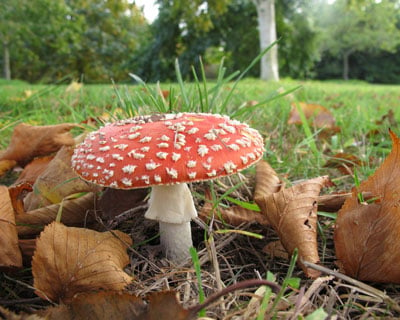10 fun facts about fungi
Did you know that the world’s largest living organism is a fungus? Delve into their mysterious world with 10 things you didn’t know about fungi
RHS Plant Pathologist Ruth Chitty shares 10 fun facts that will have you fascinated by fungi in no time.
The largest organism in the world (by area) is a fungus
A species of honey fungus (Armillaria ostoyae) discovered in 1998 was estimated to cover roughly 2,384 acres of Oregon Forest. The fungus has survived for over 2,400 years, surviving on living and dead wood.
Mushrooms (fruiting bodies) make up only a tiny part of the fungus, with the rest living underground as networks of threads (hyphae) that make up the mycelium.
Without the decomposing activities of saprotrophic fungi, we would disappear under a mountain of unrotted dead leaves and logs!
Saprotrophic fungi produce enzymes that allow them to
These processes enable the recycling and recovery of large amounts of nutrient resources (particularly carbon and nitrogen) from dead organic matter.
What’s more, over 100 species of fungi have been found to degrade plastics, with two species being able to breakdown samples of plastics within 140 days.
Fungi are more closely related to animals than to plants
Fungi are not plants or animals; they belong in their own separate kingdom. However, research has shown that fungi are closer relatives of animals than plants. In fact, the chitin that makes up fungal cell walls is also found in insect exoskeletons.
How many fungi are there?
There are roughly 200,000 known species of fungi across the globe, with roughly 15,000 found within the UK. Currently, scientists estimate that there could be another 2 million species of fungus yet to be discovered.
People have been using fungi for over 5000 years
Otzi the Iceman was discovered with two species of fungus in his pocket. The birch polypore (a white bracket fungus) found in his pocket may have acted as a natural laxative and antibiotic. Scientists think Otzi may have been self-medicating to treat gut parasites, or he was using the fungal skin as an antiseptic plaster to protect wounds.
We still use fungi in medicine today, including penicillin, an antibiotic originally manufactured from a penicillium mould.
Different species of fungi are being investigated to see if their presence can improve our gardens. Scientists at the RHS are currently exploring whether saprotrophic fungi presence in the soil can protect plants from honey fungus infection.
Fungi are in all our homes...
...and not just in the fridge! Did you know that enzymes produced by fungi are used to make other household items? Making stonewash jeans requires an enzyme produced by fungi, which breaks down the cotton to make them feel softer. Plastic used for car parts and lego are all made using a fungal enzyme, itaconcic acid.
How long have fungi been around for?
From woodlands and grasslands to sand dunes and glaciers, different species of fungi can be found in almost all ecosystems. They colonised land roughly 1.3 billion years ago (according to gene analysis), however this is still being debated as no fossils exist of these fungi. If this is accurate, fungi arrived on land roughly 600 million years before plants.
Fungi allow plants to communicate via the wood wide web
Fungi and other microbes in the soil connect plant and tree roots to create the wood wide web. An underground network of fungal threads (hyphae) links fungi to nearby trees. The hyphae feed in the soil, swapping extra
The network also allows communication about threats to the fungi and plants, such as warnings about insect attacks, droughts and diseases.
Some fungi can glow in the dark...
Over 110 species of fungi can glow in the dark. Sometimes only the underground network of mycelium can glow, while in other species, the mushrooms can glow. In the UK, a UV light can be used to see sulphur tuft mushrooms glow. It is thought that glowing mushrooms can attract insects to spread their spores.
...while others are powerlifters!
Fungal fruiting bodies such as mushrooms usually enlarge very rapidly, becoming engorged with water in just a few hours. This hydraulic pressure enables fruiting bodies to push through soil or wood so that they can reach the air to release their spores. In some fungi, such as puffballs, the hydraulic pressure can be so great that it can damage tarmac and lift paving slabs.
RHS Science holds numerous talks and demonstrations at RHS Hilltop, the home of gardening science. Check out the RHS Science's What's On page for some interesting upcoming talks on fungi.


